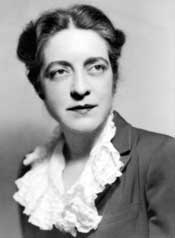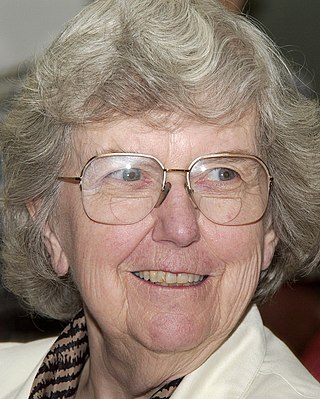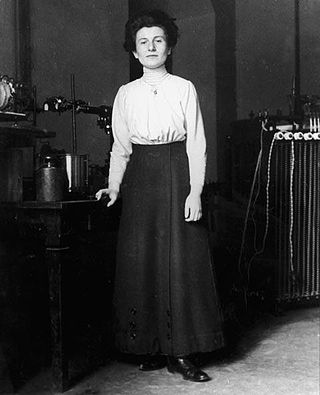Related Research Articles
Erna Schneider Hoover is an American mathematician notable for inventing a computerized telephone switching method which "revolutionized modern communication". It prevented system overloads by monitoring call center traffic and prioritizing tasks on phone switching systems to enable more robust service during peak calling times. At Bell Laboratories where she worked for over 32 years, Hoover was described as an important pioneer for women in the field of computer technology.

Melba Newell Phillips was an American physicist and a pioneer science educator. One of the first doctoral students of J. Robert Oppenheimer at the University of California, Berkeley, Phillips completed her PhD in 1933, a time when few women could pursue careers in science. In 1935, Oppenheimer and Phillips published their description of the Oppenheimer–Phillips process, an early contribution to nuclear physics that explained the behavior of accelerated nuclei of radioactive hydrogen atoms. Phillips was also known for her refusal to cooperate with a U.S. Senate judiciary subcommittee's investigation on internal security during the McCarthy era which led to her dismissal from her professorship at Brooklyn College, where she was a professor of science from 1938 until 1952.

Beatrice Alice Hicks was an American engineer, the first woman engineer to be hired by Western Electric, and both co-founder and first president of the Society of Women Engineers. Despite entering the field at a time where engineering was seen as an inappropriate career for a woman, Hicks held a variety of leadership positions and eventually became the owner of an engineering firm. During her time there, Hicks developed a gas density switch that would be used in the U.S. space program, including the Apollo Moon landing missions.

Isocyanic acid is a chemical compound with the structural formula HNCO, which is often written as H−N=C=O. It is a colourless, volatile and poisonous substance, with a boiling point of 23.5 °C. It is the predominant tautomer and an isomer of cyanic acid (aka. cyanol).

Mary Ellen Avery, also known as Mel, was an American pediatrician. In the 1950s, Avery's pioneering research efforts helped lead to the discovery of the main cause of respiratory distress syndrome (RDS) in premature babies: her identification of surfactant led to the development of replacement therapy for premature infants and has been credited with saving over 830,000 lives. Her childhood, mentors, drive, and education inspired Avery to be the visionary that she was. In 1991 President George H.W. Bush conferred the National Medal of Science on Avery for her work on RDS.

Hedwig Kohn was a physicist who was one of only three women to obtain habilitation in physics in Germany before World War II. Born in Breslau in the German Empire, she was forced to leave Germany during the Nazi regime because she was Jewish. She continued her academic career in the United States, where she settled for the rest of her life.
The Physics Department at the University of California, Santa Barbara has 58 faculty members. It offers academic programs leading to the B.A., B.S., and Ph.D. degrees.
Walter Gordy, was an American physicist best known for his experimental work in microwave spectroscopy. His laboratory at Duke University became a center for research in this field, and he authored one of the definitive books on the field.
Lucy Wilson was an American physicist, known for her research on theories of vision, optics and X-ray spectroscopy. She was also the first dean of students at Wellesley College.
Marion Clyde McCarroll (1891-1977) was a writer and journalist. McCarroll was the first woman issued a press pass by the New York Stock Exchange in New York City. She attained the press pass during the 1920s while writing for The Commercial, a daily business newspaper. McCarroll also penned the "Advice for the Lovelorn, a nationally syndicated column, after she inherited it from Dorothy Dix.

Helen Dodson Prince was an American astronomer who pioneered work in solar flares at the University of Michigan.
Dr. Maud Thompson (1870-1962) was a women's rights activist, suffragist, and teacher. Thompson held leadership positions in women's rights and suffragist associations in Michigan and New Jersey. She lectured on women's right issues at activist gatherings, including at the Paterson Silk Strike in Paterson, New Jersey. Thompson also taught classics at private schools in Connecticut, New Jersey, and New Hampshire during a 40-year career in education.

Dorothy Walcott Weeks was an American mathematician and physicist. Weeks was born in Philadelphia, Pennsylvania. She earned degrees from Wellesley College, the Massachusetts Institute of Technology, and Simmons College. Weeks was the first woman to receive a PhD in mathematics from the Massachusetts Institute of Technology.

Grace Langford was an American physicist known for her work in physics education and research on the infrared reflection of phosphates. She taught at Wellesley College and at Barnard College.
Manijeh Razeghi is an Iranian-American scientist in the fields of semiconductors and optoelectronic devices. She is a pioneer in modern epitaxial techniques for semiconductors such as low pressure metalorganic chemical vapor deposition (MOCVD), vapor phase epitaxy (VPE), molecular beam epitaxy (MBE), GasMBE, and MOMBE. These techniques have enabled the development of semiconductor devices and quantum structures with higher composition consistency and reliability, leading to major advancement in InP and GaAs based quantum photonics and electronic devices, which were at the core of the late 20th century optical fiber telecommunications and early information technology.

Louise Sherwood McDowell was an American physicist and educator. She spent most of her career as a professor of physics at Wellesley College and is best known for being one of the first female scientists to work at the United States Bureau of Standards, now the National Institute of Standards and Technology.
Alice H. Armstrong was an American physicist known as one of the first female scientists at the National Bureau of Standards and as the first woman to earn a Ph.D. in physics from Harvard University, via Radcliffe College. She was elected a Fellow of the American Physical Society in 1931.

Gretchen K. Campbell is an American atomic, molecular, and optical physicist associated with the National Institute of Standards and Technology. She works in the field of atomtronics and has received awards in recognition of her research contributions on Bose-Einstein condensates. She is currently on detail to the White House Office of Science and Technology Policy (WHOSTP), where she is the Assistant Director for Quantum Information Science at WHOSTP, and Director of the National Quantum Coordination Office (NQCO).
Walter McKinley Nielsen was an American professor of physics and one of the founders of Duke University's physics department.
Elizabeth (Betty) Frazier Karplus (1925–2021) was an American science educator, and "a pioneer in protecting rights of students with disabilities".
References
- 1 2 Siegel, Peter (2013). "Terahertz Pioneers: Manfred Winnewisser and Brenda Pruden Winnewisser". IEEE Transactions on Terahertz Science and Technology. 3 (3). doi: 10.1109/TTHZ.2013.2256392 . S2CID 8527413.
- ↑ Brenda P. Winnewisser
- ↑ "Class Notes". Princeton Alumni Weekly. 57 (29): 33. 1957.
- ↑ "Brenda P. Winnewisser". Jewish Women's Archive: Encyclopedia.
- ↑ Winnewisser, Brenda (1998). The Emigration of Hedwig Kohn, Physicist, 1940.
- ↑ De Lucia, Frank C.; Winnewisser, Brenda P. (2007). Walter Gordy. The National Academies Press.